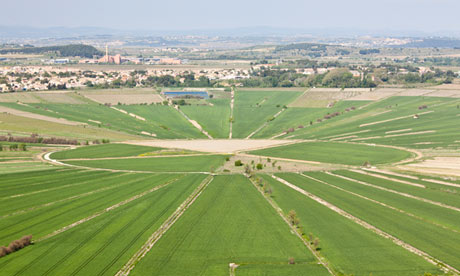
The settlements of the ancient Gauls would make a perfect theme for a misanthrope's holiday. Most of the hilltop towns of Gaul, known as oppida, are deserted heaps of rubble on the outskirts of the Roman cities that replaced them. They stand on the top of ferociously steep hills at the end of dirt tracks. Often, the only sign is a rough plank of wood like a signpost in an Astérix comic, with the words oppidum celtique.
When I began to visit these Iron Age ghost towns in 2008, I assumed the French were proud of their Gaulish ancestors. Amused disdain verging on total indifference would be closer to the mark. At a museum in Vienne, south of Lyon, a collection of Celtic gold coins had been hidden away in a storeroom. The curator told me that no one cares about the Gauls "because they lost" (the unspoken addition was "to the Romans"). S o much for Gallic pride.
Before Julius Caesar marched over the Alps, bringing slavery, genocide and underfloor heating, Celtic Gaul was one of the most highly developed parts of Europe, with long-distance roads and high-speed chariots. The tribal capitals were comfortable, friendly and had a good range of shops. Indeed the first writer known to have had a second home in Gaul was Julius Caesar. After his final campaign, which left 2 million Gauls dead or enslaved, he decided not to return to Italy for the winter, but stayed in Gaul and wrote his account of the war in "a very large and well-supplied" oppidum in Burgundy.
The name of that oppidum was Bibracte. It stood on the summit of Mont Beuvray near modern Autun, and now has a superb museum, but it's a remote and chilly place. The delights of life in a Gaulish town are easier to picture in the little oppidum of Ensérune, near Béziers. Its pine-scented terraces look out towards the Mediterranean. Far below, the arrow-straight Heraklean Way, which became the Roman Via Domitia, can still be seen bisecting the coastal plain. Along that road, enormous quantities of Greek and Italian wine were brought to Ensérune. The Gauls were addicted to the red nectar and appalled the Romans by drinking it undiluted.
I have cycled to Ensérune several times in the past five years. After stumbling on what seemed at first impossible evidence of a sophisticated Gaulish map, I reminded myself that the grimly named Iron Age was also – at least in Gaul – an age of happy invention. The exhibits in the town's quiet museum paint a sunny picture of life in the Iron Age – a hand-held sundial, counters used in a game, a child's puppet, and a dish with a small ceramic frog grinning up from the base. Outside, there is a lovely example of a murus gallicus. These walls of stone and timber were once thought to have been built as fortifications. In fact, they were a poor defence against fire and battering-rams, and archaeologists now believe that they were built that way because they looked nice.
There is no cafe at Ensérune. Take your own (undiluted) wine, gaze at the murus gallicus and the beautiful view, and imagine how much more civilised and cheerful ancient Gaul might have been without the Romans.
• Fly to Perpignan with Ryanair or Montpellier with easyJet. Rail returns from London to Béziers via Paris with RailEurope cost about £148. Hotel Résidence in Nissan-lez-Ensérune has individually designed doubles from €69 a night and fancy dining on its poolside terrace
Graham Robb's prize-winning book The Discovery of France is published by Picador (£9.99). To buy a copy for £7.99 with free UK p&p go to guardianbookshop.co.uk

